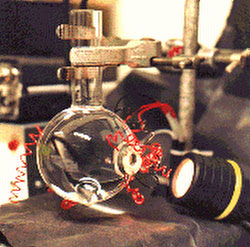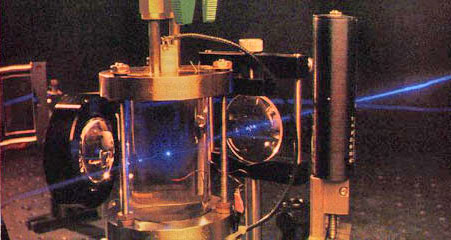







Sonoluminescence
The following article I found on the net. Unfortunately I have not yet been able to find out its author and cannot give credit, which is evidently due, because the article is telling and accurate. It is true that Keely does talk about the phenomenon, which is interesting, because it was not until 1934 that it was re-discovered at the University of Cologne as a result of work on sonar. But no more comment, here it is:
SONOLUMINESCENCE
Keely's work also involved the idea that when water was vibrated at certain frequencies, visible light would emerge within it. He tied this in with the properties of sound to harness the aetheric energies. This phenomenon has now been duplicated through an experiment that is known as "Sonoluminescence." In this experiment, a spherical flask that is filled with water is vibrated at a certain frequency, low in pitch but very high in strength. In the below image we see a simple laboratory setup for this process, with the spherical flask in a clamp and high-intensity speakers mounted to either side of the sphere, with red power wires attached.

Photo from William Andrew Steer's laboratory research.
When the speakers are running, this arrangement causes a sonic force to be directed towards the exact center of the sphere that the flask makes. Then, the scientist must introduce an air bubble into the water and carefully try to manipulate it into the center that the sound forces are pressing towards. Once an air bubble is properly fixed into the center, the vibrations will allow it to stay there, and an amazing thing happens; it starts emitting light.
At first, the scientists studying this believed that the light was constant, but now it has been shown through delicate measurements to be pulsating at a very rapid speed. The next image below shows a much more high-tech setup, where the spherical flask is housed within a special apparatus that obscures most of the flask from view.
No conventional explanation for why this might be happening exists, and many scientists have tried to explain it in conventional models. The most popular idea is that the extreme forces of sound create nuclear fusion, thus leading to the humorous term "the Star in a Jar." However, this flies completely in the face of the experiment itself, since the more that the water is cooled, the more light you get! By cooling the water, the amount of molecular vibration in it decreases, thus making it even easier for the sound vibrations to resonate purely.
Other conventional explanations for sonoluminescence sound equally absurd. However, we do know for a fact that the bubble inside shrinks significantly in size every time that a pulse of light is released, and this is occurring at extremely fast rates of speed. It is believed that this collapse creates such intense pressure that great energy is released, but the source of this energy remains a mystery to the mainstream.

Photo from an article by Aaron Levinson.
Although John Keely mentioned this phenomenon in his own work, general credit is given to H. Frenzel and H. Schultes at the University of Cologne in 1934 as being the first to discover this. They were using very strong ultrasonic fields in water as part of their wartime research in marine acoustic radar. Although they were not looking for or expecting such results, they discovered to their surprise that clouds of unpredictable and non-synchronous flashing bubbles of light were formed in the water in front of them. This is now known as "multi-bubble sonoluminescence" or MBSL. Little was done to advance this study until 1988, when D. Felipe Gaitan was able to trap a single bubble at the center of a flask that was vibrating at its own acoustic resonance level, and sonoluminescence was then seen.
Once Gaitan accomplished this effect, he became rather disinterested in pursuing it further, and Dr. S. Putterman et al. subsequently picked it up at UCLA, California. It was Putterman et al.'s research that determined that the internal bubble compresses to 1 / 100,000th of its original size due to the pressure of the sound, during which time the light is released. The flash of light is shorter than 100 picoseconds (or trillionths of a second) in duration, vibrating with extreme regularity every 100 millionths of a second. Putterman's studies eventually made it into Scientific American in February 1995, which dramatically increased public awareness and interest in the phenomenon.
An article excerpt from the Wall Street Journal on October 15, 1991 helps us to truly understand how significant this is:
…A photon of blue light given off by a single atom carries an energy of 3.5 electron volts. This is a trillion times more energy than any single atom in the tiny bubbles could have gained from the sound waves. He [Putterman] speculates that as each bubble implodes to about 1/100,000 of its original [size] volume, the energy and atoms in the bubble are concentrated to a tiny point.
The flash occurs when a million atoms simultaneously release this concentrated energy by giving off photons of blue light.
So, we can see that if we are producing a trillion times more energy than exists in the sound waves themselves in this experiment, then quite an incredible amount of energy is coming through from "nowhere." This is typically seen as a fusion reaction. However, as we have already said, by concentrating sound waves in such a fashion as this we can open up a "gateway" for the high-pressured aetheric "fluid" to flow into our physical reality, forming light, heat and energy.
Furthermore, the shape of the sphere is very important in all of this, as it helps to centralize the vibrations. An article by William Andrew Steer, working in the undergraduate teaching laboratory in the Physics Department of University College London, reveals that:
millimeter difference between polar and equatorial diameters, then t…the sphericity of the flask is very important. If there is more than a he resonance becomes very much broader and less strong, requiring more electrical drive to achieve the same sound intensity in the flask.
Next Chapter:
CYMATICS, A WAY OF LOOKING AT WAVE PROPAGATION
Contact:
Hans von Lieven, copyright
2007
















